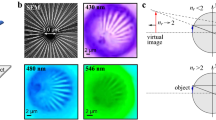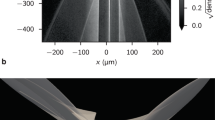Abstract
DURING the past year there have been numerous publications on ball lightning1–9, many attempting to account for the formation, properties and behaviour of lightning balls. None have questioned the reality of the phenomenon, in spite of the lack of progress toward an understanding of these baffling objects. Serious doubt about the existence of ball lightning was expressed by Humphreys10 in 1936, and more recently by Schonland11. Both regarded the phenomenon as probably an optical illusion. Now that Altschuler et al.8 have invoked nuclear reactions to account for the lightning ball it seems appropriate to re-examine the possibility of finding an explanation in the physiology of vision.
This is a preview of subscription content, access via your institution
Access options
Subscribe to this journal
Receive 51 print issues and online access
$199.00 per year
only $3.90 per issue
Buy this article
- Purchase on Springer Link
- Instant access to full article PDF
Prices may be subject to local taxes which are calculated during checkout
Similar content being viewed by others
References
Lowke, J. J., Uman, M. A., and Lieberman, R. W., J. Geophys. Res., 74, 6887 (1969).
Jennison, R. C., Nature, 224, 895 (1969).
Powell, J. R., and Finklestein, D., Amer. Sci., 58, 262 (1970).
Covington, A. E., Nature, 226, 252 (1970).
Bromley, K. A., Nature, 226, 253 (1970).
Felsher, M., Nature, 227, 982 (1970).
Hill, E. L., Amer. Sci., 58, 479 (1970).
Altschuler, M. D., House, L. L., and Hildner, E., Nature, 228, 545 (1970).
Zimmerman, P. D., Nature, 228, 853 (1970).
Humphreys, W. J., Proc. Amer. Phil. Soc., 76, 613 (1936).
Schonland, B., The Flight of Thunderbolts (Clarendon Press, Oxford, 1964).
Rayle, W. D., NASA Technical Note TN D-3188 (Washington, DC, 1966).
Bruce, C. E. R., Nature, 202, 996 (1964).
Singer, S., Nature, 198, 745 (1963).
Hill, E. L., J. Geophys. Res., 65, 1947 (1960).
Wooding, E. R., Nature, 199, 272 (1963).
Beals, C. S., J. Roy. Astron. Soc. Canad., 27, 184 (1933).
Barry, J. D., J. Atmos. Terr. Phys., 29, 1095 (1967).
Folinsbee, R. E., Douglas, J. A. V., and Maxwell, J. A., Geochim. Cosmochim. Acta, 31, 1625 (1967).
Goodlet, B. L., J. Inst. Elec. Eng., 81, 1 (1937).
Author information
Authors and Affiliations
Rights and permissions
About this article
Cite this article
ARGYLE, E. Ball Lightning as an Optical Illusion. Nature 230, 179–180 (1971). https://doi.org/10.1038/230179a0
Received:
Revised:
Issue Date:
DOI: https://doi.org/10.1038/230179a0
This article is cited by
-
Ball lightning
Naturwissenschaften (1980)
-
Kugelblitz und Blitzforschung
Die Naturwissenschaften (1973)
-
Ball Lightning and After-images
Nature (1971)
-
After-images and Ball Lightning
Nature (1971)
-
Ball Lightning or Spots before the Eyes ?
Nature (1971)
Comments
By submitting a comment you agree to abide by our Terms and Community Guidelines. If you find something abusive or that does not comply with our terms or guidelines please flag it as inappropriate.



